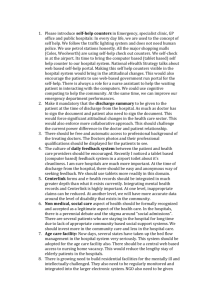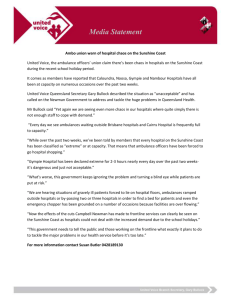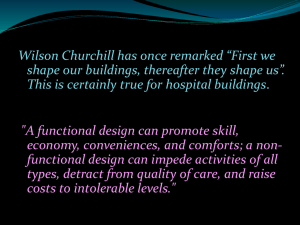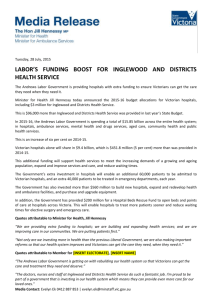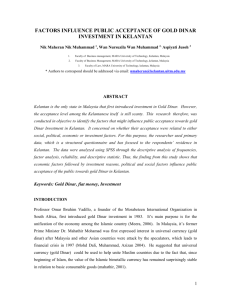Hospitals - World Health Organization
advertisement
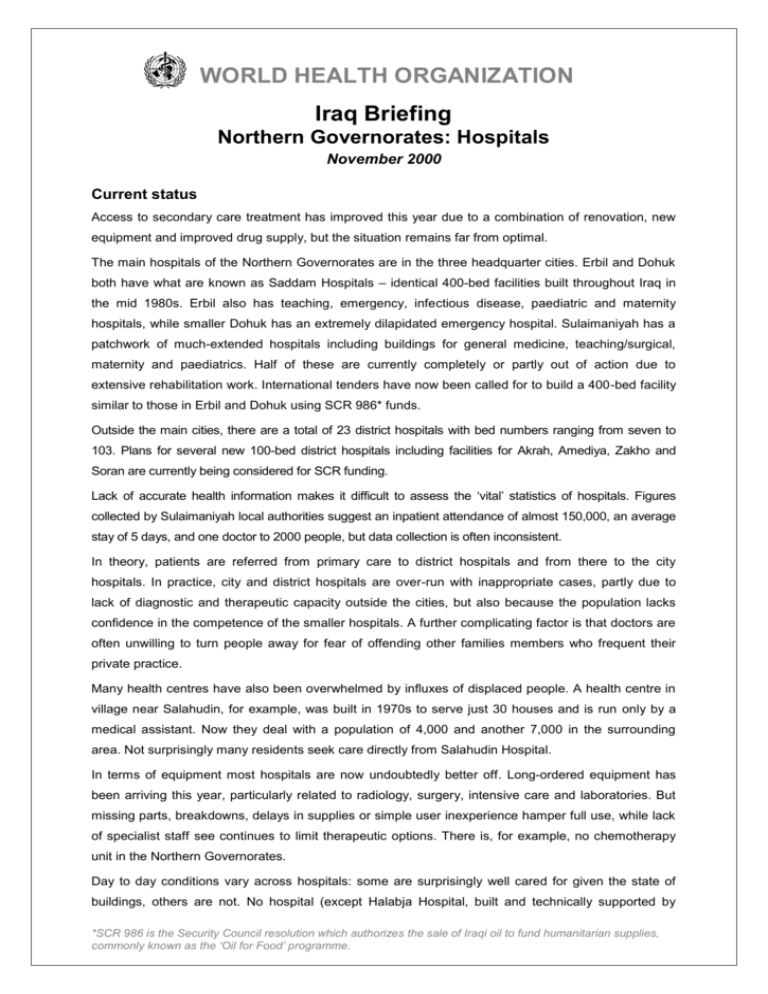
WORLD HEALTH ORGANIZATION Iraq Briefing Northern Governorates: Hospitals November 2000 Current status Access to secondary care treatment has improved this year due to a combination of renovation, new equipment and improved drug supply, but the situation remains far from optimal. The main hospitals of the Northern Governorates are in the three headquarter cities. Erbil and Dohuk both have what are known as Saddam Hospitals – identical 400-bed facilities built throughout Iraq in the mid 1980s. Erbil also has teaching, emergency, infectious disease, paediatric and maternity hospitals, while smaller Dohuk has an extremely dilapidated emergency hospital. Sulaimaniyah has a patchwork of much-extended hospitals including buildings for general medicine, teaching/surgical, maternity and paediatrics. Half of these are currently completely or partly out of action due to extensive rehabilitation work. International tenders have now been called for to build a 400-bed facility similar to those in Erbil and Dohuk using SCR 986* funds. Outside the main cities, there are a total of 23 district hospitals with bed numbers ranging from seven to 103. Plans for several new 100-bed district hospitals including facilities for Akrah, Amediya, Zakho and Soran are currently being considered for SCR funding. Lack of accurate health information makes it difficult to assess the ‘vital’ statistics of hospitals. Figures collected by Sulaimaniyah local authorities suggest an inpatient attendance of almost 150,000, an average stay of 5 days, and one doctor to 2000 people, but data collection is often inconsistent. In theory, patients are referred from primary care to district hospitals and from there to the city hospitals. In practice, city and district hospitals are over-run with inappropriate cases, partly due to lack of diagnostic and therapeutic capacity outside the cities, but also because the population lacks confidence in the competence of the smaller hospitals. A further complicating factor is that doctors are often unwilling to turn people away for fear of offending other families members who frequent their private practice. Many health centres have also been overwhelmed by influxes of displaced people. A health centre in village near Salahudin, for example, was built in 1970s to serve just 30 houses and is run only by a medical assistant. Now they deal with a population of 4,000 and another 7,000 in the surrounding area. Not surprisingly many residents seek care directly from Salahudin Hospital. In terms of equipment most hospitals are now undoubtedly better off. Long-ordered equipment has been arriving this year, particularly related to radiology, surgery, intensive care and laboratories. But missing parts, breakdowns, delays in supplies or simple user inexperience hamper full use, while lack of specialist staff see continues to limit therapeutic options. There is, for example, no chemotherapy unit in the Northern Governorates. Day to day conditions vary across hospitals: some are surprisingly well cared for given the state of buildings, others are not. No hospital (except Halabja Hospital, built and technically supported by *SCR 986 is the Security Council resolution which authorizes the sale of Iraqi oil to fund humanitarian supplies, commonly known as the ‘Oil for Food’ programme. WORLD HEALTH ORGANIZATION Swedish NGO Qandil) uses sheets. Sterile procedures are sorely underused and infection rates are high. All mothers giving birth in the Sulaimaniyah maternity hospital are, for example, routinely given antibiotics. Hospital care is free but some patient fees do exist. Consultation and prescriptions in both primary and secondary care cost 1 northern dinar ($1=18 dinar) in Erbil and Dohuk while an X-ray costs around 5 dinar and a CT scan 250 dinar. Public hospital consultations, except for emergencies, close down at 1pm since almost all senior doctors, laboratory technicians, radiologists run afternoon private clinics in order to compensate for their meagre salaries. WHO activities Renovation: Under SCR 986, WHO is responsible for rehabilitating existing hospitals and implementing new building projects, such as the 400-bed Sulaimaniyah Hospital. It currently maintains ‘renovation’ teams including architects, surveyors, civil and electrical engineers at all three field offices who work with local contractors to see the project through from design to completed building. However, it is likely that WHO will relinquish this direct involvement in construction in the near future and focus on supplying local authorities with technical support. Procurement: WHO headquarters in Geneva is directly responsible for procuring equipment according to requests made by the local authorities in each phase. WHO biomedical engineers deliver and, in many cases, install the equipment. They also follow up on missing accessories and spare parts – an activity made more complicated by the fact that equipment often arrives a year or more after the original request. Issues Planning vacuum: Though plans are on the table to build several new hospitals, the two local authorities have yet to develop a comprehensive health plan for the region based on in depth analysis of health needs. Producing accurate health information data is a key first step and one which WHO and health authorities are about to address. Human resources: The ‘brain drain’ of the past 15 years has left most hospitals severely lacking in medical staff, while nursing staff suffer from poor training and salaries and undeveloped roles in the system. Increasing nursing share in the management of patients is seen as a priority, not only to help compensate for shortage of doctors but to improve care and outcomes. (See Iraq Briefing: Human Resources) User fees: Many hospital directors believe introducing a fee would significantly but equitably reduce patient overload. For further information, please contact: Gregory Hartl, Office of the Spokesperson, WHO, Geneva. Telephone: (41 22) 791 2599. Fax: (41 22) 791 4858. Email: hartlg@who.int




